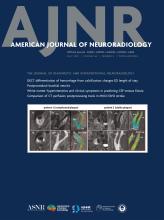This article requires a subscription to view the full text. If you have a subscription you may use the login form below to view the article. Access to this article can also be purchased.
Abstract
BACKGROUND AND PURPOSE: EPIMix is a fast brain MRI technique not previously investigated in patients with grade 3 and 4 gliomas. This pilot study aimed to investigate the diagnostic performance of EPIMix in the radiological treatment evaluation of adult patients with grade 3 and 4 gliomas compared with routine clinical MRI (rcMRI).
MATERIALS AND METHODS: Patients with grade 3 and 4 gliomas investigated with rcMRI and EPIMix were retrospectively included in the study. Three readers (R1–R3) participated in the radiological assessment applying the Response Assessment for Neuro-Oncology (RANO 2.0) criteria, of whom two (R1 and R2) independently evaluated EPIMix and later rcMRI by measuring contrast-enhancing and non-contrast-enhancing tumor regions at each follow-up. For cases with discrepant evaluations, an unblinded side-by-side (EPIMix and rcMRI) reading was performed together with a third reader (R3). Comparisons between methods (EPIMix versus rcMRI) were performed using the weighted Cohen κ. The sensitivity and specificity to progressive disease (PD) on a follow-up scan were calculated for EPIMix compared with rcMRI with receiver operating characteristic curves (ROC) to assess the area under the curve (AUC).
RESULTS: Of 35 patients (mean age, 53 years; 31% women), a total of 93 MRIs encompassing 58 follow-up investigations showed PD at a blinded reading in 33% of EPIMix (19/58, R1–2), while in 31% (18/58 exams, R1), and 34% (20/58 exams, R2) of rcMRI. An almost perfect agreement for tumor category assessment was found between EPIMix and rcMRI (EPIMixR1 versus rcMRIR1 κ = 0.96; EPIMixR2 versus rcMRIR2 κ = 0.89). The sensitivity for EPIMix to detect PD was 1.00 (0.81–1.00) for R1 and 0.90 (0.68–0.99) for R2, while the specificity was 0.97 (0.86–1.00) for R1 and R2. The AUC for PD was 0.99 for R1 (EPIMixR1 versus rcMRIR1) and 0.94 for R2 (EPIMixR2 versus rcMRIR2). The P value of the DeLong test AUCR1 versus AUCR2 was P = .20 (R1–R2).
CONCLUSIONS: In this pilot study, EPIMix was used as a fast MRI alternative for treatment evaluation of patients with glioma grades 3 and 4, with high but slightly lower diagnostic performance than rcMRI.
ABBREVIATIONS:
- AUC
- area under the curve
- CNR
- contrast-to-noise ratio
- CR
- complete response
- EPIMix
- multicontrast echo-planar imaging–based technique
- PD
- progressive disease
- PR
- partial response
- RANO
- Response Assessment in Neuro-Oncology
- rcMRI
- routine clinical MRI
- ROC
- receiver operating characteristic
- SD
- stable disease
- SNR
- signal-to-noise ratio
- © 2025 by American Journal of Neuroradiology












